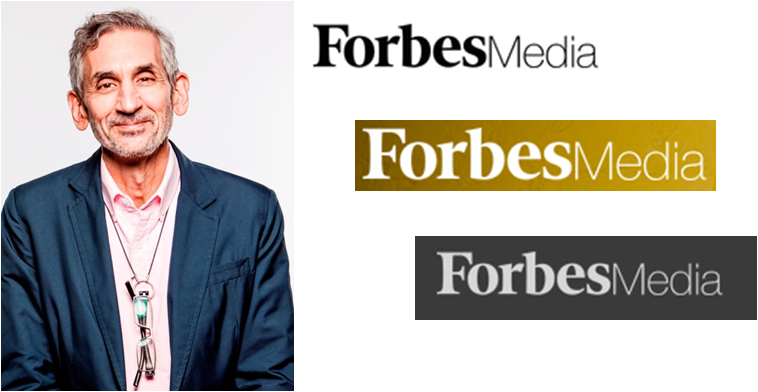DIS catch-up with Lewis D'Vorkin from Forbes Media
Lewis D'Vorkin, Forbes Media Chief Product Officer talks about how a trio of innovations have made the brand a huge online success.
A couple of decades ago if media analysts been asked to predict which of the major US print publications would be at the cutting edge of the digital revolution they would probably have overlooked Forbes. The business based magazine, which was formed as long ago as 1917 by the current Editor in chief's grandfather, has however prospered in the online media era while many of its rivals have faltered.
Much of its success can arguably be attributed to a trio of innovations which it introduced earlier in the decade. Firstly it pioneered a unique content creation model (an expert contributor network that included experts and pundits and not just journalists). Then Forbes rebuilt the newsroom labour model - an incentive-based payment plan for contributors. Lastly it pioneered native advertising with its BrandVoice platform, arguably the best of the early incarnations of that format.
Much of the way in which Forbes.com has been transformed has been down to Lewis D'Vorkin. In some ways he is an unlikely digital guru given his long and influential career in print journalism. Yet the man credited with igniting huge traffic and serious revenues at Forbes.com has become a key maven in the digital word. When he talks, people tend to stop and listen.
Lewis spoke at the Digital Innovators' Summit (DIS) in Berlin, Germany, in 2012 (in 2016, the DIS takes place from 20-22 March – find out more about next year's event, here). Here, Ashley Norris catches up with Lewis for the DIS.
The incentive based contributor model (writers are paid according to the size of the audience they attract) obviously works for you. Other companies like Gawker have experimented with it, but why do you think it hasn't been more widely copied in the industry?
It has been copied in varying degrees by many organisations. They don't talk about it as openly as we do and they haven't implemented as deeply as we have. Often they use the term freelancers and they still pay by the word or the story. It's not easy to implement an effective incentive model. In fact, it takes a commitment throughout the organisation.
Forbes has built up a reputation for targeting Millennials. Why do you think Forbes has been so successful in attracting them?
Millennials will soon represent 50% of the worldwide workforce, and the relentless use of mobile devices for everything is being driven by their preferences on how to consume content, share it and communicate. Forbes is about success. Forbes is about aspiration. Both cut across all generations, from boomers, to yuppies, the millennials, to whatever come next.
BrandVoice is one of the most interesting and extensive native advertising programmes from a major publishers so far. Where will you take it next?
BrandVoice will continue to evolve, on Forbes.com and in Forbes magazine. Look for new digital pages that more seamlessly combine editorial and BrandVoice, always fully transparent and clearly labelled. In print, we have many ideas for BrandVoice treatments that further integrate marketing content, again always labelled as such.
How do you feel about the widespread use of ad blockers? Is Forbes attempting to work out ways to get round them? Or do you think they might be the do knell for display advertising - at least on mobile?
Ad blockers are an issue. I'm a guest Skype instructor at my alma mater and when I asked students if they used ad blockers 75% of them raised their hands. Forbes doesn't face the same use of ad blockers as other sites, but we continue to monitor the situation. Remember that line in Jurassic Park, where dinosaurs of the same sex found a way to mate. Just as life found a way in Jurassic Park, display ads will find a way on the Internet.
There does seem to be a wave of US publishers now extending their offering to Europe and performing well. Yourself, BuzzFeed, Politico etc. Do you think it is becoming easier for US media companies to succeed in Europe? What advice would you give to European brands eyeing up the US market?
To be bold, inventive and disruptive. It's a noisy market that requires new ideas and ways of doing business to succeed.
Which of the social platforms is most important to Forbes now? Do you think that this will be the case in the future? What platforms should publishers be looking at?
Facebook and Twitter remain important to Forbes, but Google search is still critical to our business. I would advise paying attention to any platform that stresses the visual over text.
Do you have plans to expand your video output? You seem to be moving a little slower on this area compared with some of your rivals?
Yes, we're now bringing on video contributors, and the early signs are quite encouraging. We're also producing more video by aligning our content channels more closely with our video team. It remains a work in progress, as it does for all news organizations. The name of the game in video is distribution and we're working very hard on that.
How crucial is longform content the future of Forbes?
Our magazine content is vital to Forbes.com. Deep investigative reporting is highly valued on the Web and the discipline of creating it for our magazine is what sets us apart from many of the new content startups that are building audience with aggregated content or, in some cases, by pandering to social audiences.
You have had a long and fascinating career in the media. How important is perspective now when relating to digital audiences? Do the lessons learned in the days of broadcast and print still apply?
I often say there is nothing new in the media business — except the technology. The trick is to apply all the lessons learned over the decades to the new technology at our fingertips.
What is the rationale behind the series of apps that you are developing? How do you plan to monetise them? Is it all about brandvoice/native advertising?
Advertisers want targeted audiences and scale. Our new Under 30 app enables marketers to get out their messages to millennial influencers – the cream of the crop. At the same time, much of the content produced on the app by thousands of Under 30's (expert content in its own way) will be used for a new Under 30 channel on Forbes.com. That Web experience will provide marketers with audiences at scale. We will then repeat this strategy for other passionate communities, creating a platform of apps with corresponding Web expressions.
Are there any publishing or digital startups that have impressed you?
I follow them all. I never like to name. However, there is one that I find uniquely intriguing. In fact, I'm on its board of directors. The Mighty is a site aimed at children with autism and other diseases – and their parents, too. It's using a contributor model to get stories out there that are both inspirational and helpful to families. I believe it is serving communities the way the Web can. I also believe it will be able to connect families with pharmaceutical companies in ways that other sites cannot.





